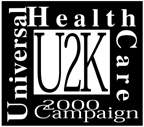Intro | Private Ins. | Medicare | Medicaid | Managed Care | Crisis | Reform

|
Medicare |
History
Medicare was enacted in 1965, as part of President Johnson's Great Society program. Advocacy for it began nearly a decade earlier. The Medicare strategy was created by leaders of the failed attempt to obtain national health insurance in 1949 under President Truman. They reasoned that, if they couldn't get coverage for everyone, they should start with the most needy and vulnerable group. Medicare provides coverage to all elderly, regardless of income. In 1972, Medicare was expanded to include care for the chronically disabled and people in kidney failure needing expensive dialysis.The benefit plan created in 1966 mirrored private insurance at the time, including co-payments and deductibles. As care became more expensive, more and more people obtained insurance to pay these costs, through supplemental insurance, often called "Medigap." This is sometimes provided by former employers as a retirement benefit, sometimes purchased individually and sometimes provided to the very poor through Medicaid.
Originally Medicare paid hospitals and doctors as private insurers did, retrospectively, paying individually for each item of care through fee-for-service schedules. As technological advances made health care more expensive, in the 1980s Medicare switched to prospective payment, paying a fixed price for a hospital admission for a particular diagnosis, regardless of individual costs (the DRG system). This controlled Medicare hospital expenditures, but led insurers, hospitals and physicians to "cost-shift" to private insurers and employers, leading to the double digit health inflation of the late 80s and early 90s.
Current Status:
Medicare coverage and expenditures, 1995:
| # covered | per capita expenditures | |
| Age 65 and older | 33,100,000 | $4193 |
| 65-66 | $2546 | |
| 69-70 | $3249 | |
| 75-79 | $4616 | |
| >85 | $6356 | |
| Disabled, <65 years old | 4,900,000 | |
| End stage renal disease | 204,000 | $38,960 |
Medicare spending as a % of total spending by sector, 1995:
| Hospitals | $110.6 billion | 32% |
| Doctors | $ 39.7 billion | 20% |
| Nursing homes | $ 7.8 billion | 10% |
Current Policy Issues:
Medicare is America's largest, most important and most successful health insurance program. Like all health programs, it is under constant cost pressure from advances in medical care and the graying of the population. Conservatives and elements of the insurance industry want to cope with this by forcing more Medicare recipients into HMO's. Empirical evidence has shown that this hasn't worked because healthier patients tend to choose HMO‚s and sicker patients prefer the freedom of choice of traditional Medicare. Consequently, many HMO's were being paid more by the government than they needed to spend for their enrollees. In 1998, when the government tried to address this issue by reducing payment rates, 50 managed care plans quit Medicare entirely and another fifty left certain areas.
In the 1960s, when the Medicare benefit package was designed on the model of private insurance, it did not include pharmaceuticals. Scientific advances have led to the availability of many new drugs to control chronic disease, prevent disastrous complications and improve the quality of life. How best to extend drug benefits to Medicare beneficiaries has become a major policy issue in Medicare.